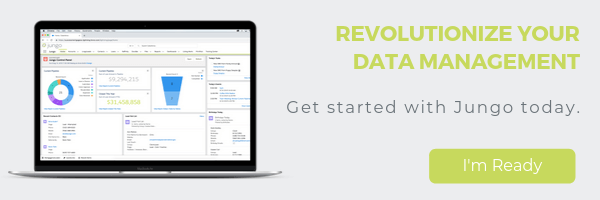
What do your CRM, LOS, PPE, and electronic loan application portals have in common? You may answer “Loans,” and you’d be correct. However, there is an even more elemental feature they all have in common.

If you answered, “Data,” then you’ve hit upon one of the most important building blocks for today’s loan originators. In fact, we’d go so far as to say that data is a critical factor for most of today’s businesses and industries!
Data is a critical part of our world because it informs much of a business and customer experience. Because with data, businesses can make educated decisions regarding their future. Additionally product planning, marketing strategies, customer communication, and much more are also made more powerful with data.
As a loan officer, data is just as critical to your success. Correctly collecting, managing, and harnessing a loan officer database can help you in many ways. Such as, originating more loans, perfecting your customer experience, and planning for your future.
There are five basics to consider if you’re wanting to revamp your data strategies, or create a new data plan.
Creating a Data Plan
The first step to any successful business strategy is to create a plan. And managing a loan officer database is no different! Whether you’re just starting out in the mortgage industry or have decades of experience, the growing world of data management is a whole new realm of opportunities. You may already have a data strategy in place, but it’s still a good idea to reevaluate regularly. Then, you can determine if your goals have changed at all.
Define Your Goals
The first step is to define your data goals. What are you hoping to gain from managing your data well? Would you like to increase your insight into your current client base? Do you want a better idea of what potential borrowers need? Would you like to know how the mortgage market affects your business?
Another way to think about data is to map out an ideal marketing campaign. Let’s say you have a goal of one refinance a month so you need to find past clients where it would make sense to do a refi. So, what are the pieces of information you’ll need to know to refinance a past client? The most obvious: the borrower and co-borrower’s names, emails, and phone numbers, their current interest rate, the loan origination date, and the total amount of the loan. With this information, you’d be able to tell if you could save them any money on their monthly payment by refinancing. This data then becomes a part of your overall data plan.
TRY IT: A Loan Officer Database Mapping Exercise
- What do you want to achieve? Define a result.
- What do you need to do to achieve that result? Define the action.
- What do you need to know before you can take that action? Define the data.
- Where does that data exist? Define the data source.
- How can you make sure that data is in an easy-to-use location? Define the data collection process.
Whatever goals you are hoping to achieve in your business, defining them will help you determine the data you’ll need to collect. Plus, if you have clearly defined goals from the outset, you’ll be able to better gauge your rate of success in the long term.
Determine How You Currently Use Data
Once you’ve decided how you’d like data to affect your business, it’s critical to understand what your current data plan is. You may store client and market data, but not manage or use it in any way. Or perhaps, you’re not even clear if you store data, or if you do, how to view it. Or maybe you’re a data management expert, and you just want to take your plan to the next level.
Performing a data audit is one great way to get started on this journey to great data insights. A data audit can be a time consuming process. However, understanding what data you have access to, how it is stored and tracked, and what you currently do with any data you may have is absolutely critical. After all, how are you supposed to manage your data if you don’t even know what you have to manage?
Plan How You Would Like Your Data to Help You Reach Your Goals
Okay, so you know what you’d like to do with your data. And you know what data you already have access to. So you now can decide how to connect the two. This determination will likely vary depending on the type of goals you’ve set, and the size and scope of your data. But, consider how the data you already have (or could have) could help you reach your goals.
For example, maybe you would like clearer insights into potential borrowers, and you already collect data such as average age, income, and other demographics of customers. Using this information, you could take a deeper look at your loan officer database. Doing so could show what unifying factors you can see between mortgage customers. This may help you determine how best to approach dealings with future customers.
Collecting Data
Now that you have a data plan in place, you can start collecting data. You may already have data collection methods in place. But, if you don’t, you want to consider carefully how you should go about this.
It’s of the utmost importance to respect your customers’ privacy above all else. With that in mind, whatever data you do collect, needs to be with their permission. For instance, you may have a form on your website for potential borrowers to get in contact with you. You should include a checkbox to give you permission to contact them regarding their inquiry.
Validating and Cleaning Data
Simply having data isn’t enough. You also need to be sure that your loan officer database is accurate and usable. With this in mind, any data you collect needs to be carefully vetted to be sure that it is true. For instance, if you have a new borrower’s data in hand, you should compare that data to the original documents they submitted. This will help confirm that the information you have on file is correct.
Another step on the road to clean and helpful data is determining how you label various pieces of data. For instance, it will be a huge roadblock to your efficiency if you label a client’s phone number in different ways. Imagine if you have labels like “Phone Number,” “Number,” and “Phone,” all referring to the same type of data! Deciding ahead of time how you will name your data will help save you time in the long run.
Protecting Data
As mentioned above, your client’s personal data is an extremely sensitive commodity. Because of this, it’s critical that you take every step possible to protect their data. After all, between social security numbers, bank statements, pay stubs, and more, your borrowers have trusted some of their most personal information to your care.
Therefore, investing in data security measures isn’t just a good idea, it’s an absolute requirement in today’s data driven age.
Invest in Software
The number one priority of software development companies in today’s culture is security. Jungo is no different–we take our customers’ (and your customers’!) data safety extremely seriously. And Salesforce, as the world’s #1 CRM platform, knows exactly what it takes to keep data safe and secure.
Being built on Salesforce means that Jungo also features the world class, cloud based data security that Salesforce is known for. Cloud based data security is an especially safe data management option because it means that all data is stored off-site and digitally. Because of this, your data can’t be damaged by a flood, break-in, or other physical attacks.
Additionally, the data security options available through the cloud means that Salesforce’s cyber security team is keeping your data safer than any other data storage option.
Using a Loan Officer Database
Now that you’ve taken all of these preparatory steps, it’s finally time to start using your data to help your business. The most important thing to remember while using data to make business decisions is to always think twice (or many more!) times. Wondering what we mean? Well, imagine that you’re trying to make a very important decision about your marketing efforts in the next business year. You decide to use customer data to help you make an informed decision–great thinking!
But it’s important to not jump to any conclusions based on a small sample of data. After all, imagine if you looked at data points from just a few past customers, and determined that your average borrower age was 65 years old. Based on this data, your marketing strategies would likely look vastly different than if you reevaluated a larger amount of data and realized that your average borrower was actually decades younger.
Leveraging Data
One way to leverage your data is through the built in capabilities of your CRM. For instance, you can run reports in Jungo that will give you insight into your database. There are many types of reports you could run, including recent loans closed, current loan pipeline, clients with loans closed above a certain interest rate, and much more. The opportunities for how you could use this information is nearly limitless. And it’s all based on you having a complete and well-organized database.
CRM Tip
When you create a custom report in Jungo, anytime the report’s data is updated in Jungo, your report also updates. When you create reports for the key business metrics you want to track, all you have to do is look at the report to have a better understanding of your business.
Bottom Line
Data isn’t everything in the mortgage industry, but it is a lot.
Using data to pursue further success is a huge opportunity for today’s loan officers. Just remember that having a loan officer database isn’t the same as having useful data. Additionally, it’s critical to hold customers’ privacy as the most important factor when deciding how and when to collect information.






